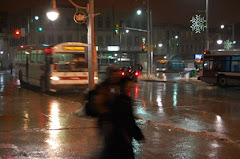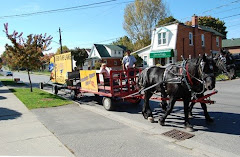 In today's Guelph Beat in Echo, there's a piece about last week's Transit Growth Strategy and Plan. However, due to the limited space I'm afforded in Echo, I could only include so many details. Enter The Politico. If you want to learn more about the transit strategy, read on. It's a bit longer than some of my regular posts, but it's an informative read, I think. Especially if you're interested in transit issues.
In today's Guelph Beat in Echo, there's a piece about last week's Transit Growth Strategy and Plan. However, due to the limited space I'm afforded in Echo, I could only include so many details. Enter The Politico. If you want to learn more about the transit strategy, read on. It's a bit longer than some of my regular posts, but it's an informative read, I think. Especially if you're interested in transit issues.Guelph’s Transit Growth Strategy and Plan was addressed in two sessions last week at the Evergreen Seniors Centre and City Hall, respectively. After a public meeting last December, over 1,100 completed written surveys, 6,000 online surveys and interviews with members of council and transit stakeholders, the crew of Dillon Consulting unveiled their master plan, which was, to say the least, ambitious.
I had the opportunity to be a proverbial third wheel as Ward 3 Councillor June Hofland was taken through the proposed changes by Richard Puccini, a transportation consultant with Dillon. The plan was broken up into three areas: improvements to mobility service, changes to conventional bus service and the assessment of Higher Order Transit for the city (ie: light rail, use of Guelph Junction Rail lines and intercity transit). The overall vision of the project, to summarize, is to make public transit the preferred mode of transportation for everyone in the City of Guelph be they resident, worker or visitor.
 But before learning where we’re going, the presentation began with an appraisal of where we are and how well – and not so well – we’re doing it. Among the common complaints was the need for better communication about transit changes, not enough service during peak hours and too much during off, and the indirectness of current transit routes. As for reasons why respondents weren’t taking transit, the top three included preferred to drive own car, working in city but living in another town, and inconvenient schedule.
But before learning where we’re going, the presentation began with an appraisal of where we are and how well – and not so well – we’re doing it. Among the common complaints was the need for better communication about transit changes, not enough service during peak hours and too much during off, and the indirectness of current transit routes. As for reasons why respondents weren’t taking transit, the top three included preferred to drive own car, working in city but living in another town, and inconvenient schedule.How about why people use transit? Finishing number one in that category was environment, followed up by more pragmatic answers like “no alternative” or “my bus pass comes with my tuition so I might as well use it.” By the numbers, transit runs nearly 250,000 trips a day. On the downside, 38 per cent of businesses surveyed said that less than one per cent of their work force takes transit, however the next largest proportion, 15.2 per cent of business, said that over 20 per cent of their staff got to work on the bus.
Before getting in to the plan, Dillon had a board that articulated the vision they saw for transit going into the future: “Guelph transit is the preferred transportation mode for residents, employees and visitors of Guelph over the single occupant vehicle.” Now this is a multifaceted approach which includes biking, walking, and carpooling. Also kept in mind as these options were developed is the provincial energy strategy, as well as a recognition that outside factors like density, parking and gas prices will also play a part in getting people on a bus. “What we’re doing here is showing the opportunities,” said Puccini. So let’s begin.
First up were improvements to the city’s mobility service and according to the survey, ridership on Guelph’s mobility buses hasn’t increased in the last few years. The thing is though, it will. With an aging population, the city will need to expand past one mobility bus running four hours a day. Instead Puccini and his fellow consultants recommend getting a second bus and a north and south route. Further, the consultants talked about targeting those routes to the amenities and locations that seniors frequent. It’s hoped that within two years, ridership will expand by 25 per cent and then expand to 60 per cent in five years.
Conventional service is where things really get interesting. First, it was noted in the surveys that despite an overall excellent record of service, transit is still slipping so far as areas being underserviced or dealing with the fact that sometimes bus demand is either overwhelming or unable to meet demand. The perimeter routes have limited hours and don’t pick up nearly as many people in the north end of the route as it does in the south. And there’s a constant increase in ridership at the university that has to be addressed, but at the same time a new plan can’t lose focus of the downtown core.
So what to do? Puccini explained that a grid system was out of the question because the nature of the layout of Guelph streets makes it impractical. Instead, the Dillon team is recommending a complete teardown of the current routes and make the straight shot of Gordon, Norfolk and Woolwich the primary transit corridor of the city. They also suggest adjusting route lengths to make runs 15 minutes during peak and 30 minutes off peak. Sound complicated? It is, but with the new transit hub being developed at Carden and Wyndham in time for the arrival of GO trains in 2011, there’s never been a better time for a full-bodied redevelopment of the bus system routes.
The key to this plan is the Gordon/Norfolk/Woolwich corridor. The downtown and university will continue to act as hubs where people can transfer, but in addition there will be other hubs at Wal-Mart in the north end and Claire at Gordon in the south end. Additionally, several routes will be reconstructed to service specific quadrants, which will also avoid a lot of the back-tracking that bus routes currently do. “Can we tweak?” Puccini asked. “No, it’s broken and it needs to be fixed.”
Another part of the new system is the use of specialty buses. For instance, having express buses specifically assigned to ferry riders from different points to the university, or to factories in the Industrial area. “You can’t design a system that needs 30 people on the bus to be productive,” said Puccini. The also means an expanded service on weekends as well, but instead of running all weekday routes on Sunday but later, the Dillon team advices special Sunday routes, again using the Gordon/Norfolk/Woolwich corridor as a focal point.
Which brings us to the final part of the three step plan: H.O.T. or High Order Transit. High Order Transit goes beyond the basic city bus system and looks at rail options and inter-city travel. Sadly, for people looking forward to a light rail option in the city (ie: street cars), Puccini says it’s impractical given the city’s infrastructure, road size and lack of necessary supporting components (like overhead electric lines).
However, there is room for a rail option in Guelph and the bonus is that we already have the infrastructure in place and we own it. That’s right, this is where the Guelph Junction Railway lines come in to play. And to utilize them, Dillon is suggesting a system similar to Ottawa’s DMU. Think of train without a locomotive, and that in the first car there’s a diesel engine that propels the DMU as it travels from the future home of the innovation district in the southeast end of the city, to the Hanlon Express area in the northwest end. It would a 30-minute, 20 mile per hour trip from one end of town to the other, but it’s one that could be put in place tomorrow, according to Puccini.
But the Dillon team also advices the city to think about “the triangle.” That is the triangle of Guelph, K-W and Cambridge. Puccini says that there are a number of options that could be implemented in an inter-city transit option, including bus lanes between Guelph and other areas, setting up U-pass style deals with Conestoga College, and perhaps even running DMUs not just to K-W and Cambridge, but run them between Guelph and Georgetown, Fergus, Milton, even Hamilton. Puccini pointed out that Cambridge, as it stands currently, is extremely underserviced with only a few Grand River Transit buses running between it and Kitchener.
Overall though, Puccini said Guelph’s ahead of many southern Ontario municipalities with 6.1 per cent of the city population taking the bus as their primary form of transportation. Still 65 per cent are single person auto-centric and the city will need to take steps to discourage that while also encouraging a dynamic, multifaceted approach to transportation.


















No comments:
Post a Comment